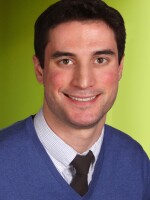The Innovation Trail is taking a look at how the thousands of refugees coming to upstate New York are weaving their way into the region's economy. You can find more from the series here.
Turnout may be low this night because of first snow, Nicole Watts tells those gathered in her entryway. Even as she tries to explain this, there's a near steady knock on the front door.
Every Tuesday evening, this home at 129 Lilac Street on Syracuse's Northside turns into a community center.
Watts runs a group called HopePrint. After living in the suburbs, she and some others have basically embedded themselves on the Northside by buying two houses on this block. That’s allowed them to follow the ups and downs of the ethnically diverse neighborhood pretty closely.
"We can share in that struggle or share in that opportunity versus them sharing it and us attempting to understand it from a distance," she said.
An hour later, every corner of Watts’ home is full of refugees and long-term residents of the neighborhood. The youngest scribble with crayons and in the living room, the adults are practicing English. Other volunteers work on preparing dinner in the kitchen.

Agnus Aombe lives in the house. Born in war-torn eastern Democratic Republic of Congo, she came to Syracuse three years ago with some younger siblings and her son. The others all live in foster care, but Aombe found a welcome home on Lilac Street.
"They're trying to view that relationship as a person, not just a language," she said. "Because when you have a relationship with somebody, even if you don’t speak the same language, they’re more patient and willing to understand and help."
For Lorina Mpinga, who was a teenager when she arrived from D.R.C, figuring out high school without knowing English proved to be a massive challenge.
Mpinga was bullied her first year in high school. She had a hard time standing up for herself at first without English language skills, but eventually got the courage.
"I have to make sure I tell them and let them know who I am, not a little scared girl and I don’t want to live a life of being scared of going to school every day," she said.
Asked whether or not being bullied as a teenager put a damper on coming here, Mpinga quickly dismisses the idea.

"I know, from before, that you always have to stand up for yourself" and being a teenager anywhere in the world is tough, she added.
A changing neighborhood
In the past decade, more than 7,200 refugees have found new homes in Syracuse, according to the U.S. State Department. A majority of those are from Burma, Bhutan and Somalia. But Sudanese, Congolese and Iraqis have also found refuge on the city’s Northside.
Now, in a walk through the neighborhood, you’ll pass newly opened Asian grocery stores and Italian bakeries, a sign of the old and new immigrants who populated this part of the city decades ago.
City officials recognize the refugee community as a source of new population and key to revitalizing the Northside, but for now it’s still a working class neighborhood that has its fair share of crime and vacancy.
Michael Collins oversees housing efforts for InterFaith Works’ Center for New Americans, one of the two charities in Syracuse that resettle refugees. Property values in the area are improving, he said.
"We’ve seen people choosing to invest in the housing on the Northside," he said during a visit to InterFaith's offices. "What we’re finding is we’ve got active investors that are buying up properties that otherwise might go vacant."
So that’s the good news, but the factory jobs that used to be open to immigrants with little or no English are gone.
...the factory jobs that used to be open to immigrants with little or no English are gone.
"There are no places like G.E. anymore, there are no places where you could move up doing a manual labor type job [and] all you need is training basically," Susan Ohlsen from InterFaith Works said.
Job training programs run through various non-profits help new Americans get jobs in health care or construction, but finding refugees steady work en masse is a challenge, according to Ohslen.
Refugees are finding work, she said. Agriculture is a good source of jobs and some high-tech manufacturers are seeking out refugees to fill their ranks, once their language skills are good enough.
Stress and anxiety
Back at 129 Lilac Street, as teenager girls use yarn and metal washers to make craft, Agnus Aombe is downstairs in the kitchen putting away dishes.
This home is a place where Aombe can be herself and let her guard down, but there have been times since arriving in Syracuse where that wasn't the case.
"It’s hard; stressful," she said with a long sigh. "It can bring anxiety and depression, everything. Because now I’ve made these steps, so let me look forward to my life in five years, but instead of that you start looking to your life back because you have to start learning what you could have done."
She may never feel fully settled here, but Aombe said it's slowly getting better.








